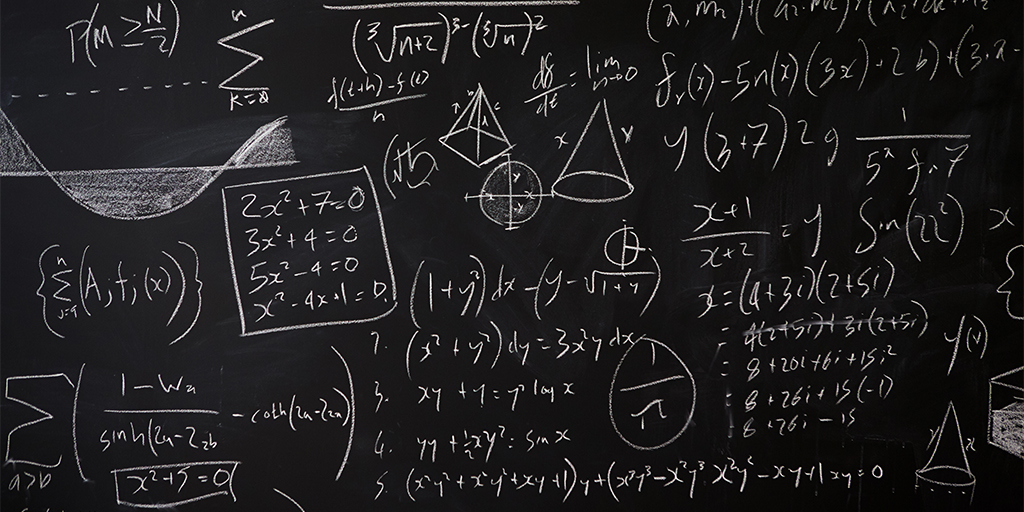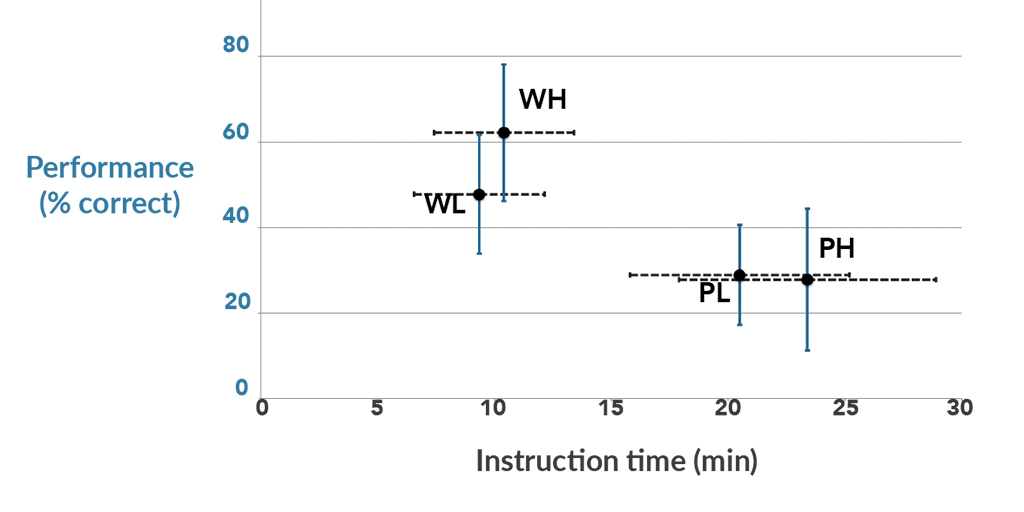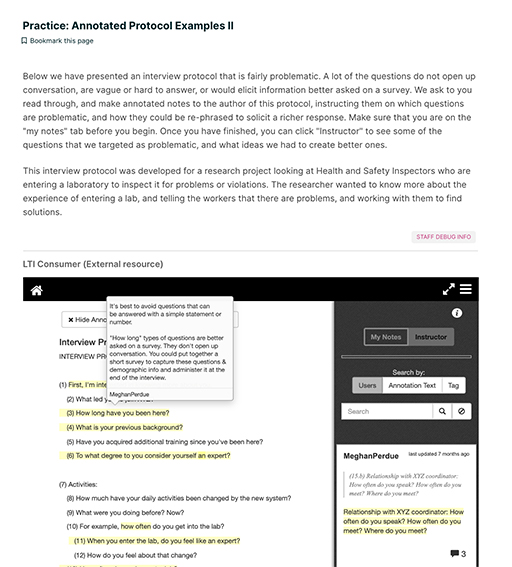
What are worked examples?
Worked examples are step-by-step illustrations of the process required to complete a task or solve a problem. In a worked example, students are provided with the task or problem formulation, the procedure or the step-by-step process for solving the problem, and the solution. When using worked examples effectively, instructors engage students in self-explaining these procedures or solutions, encouraging them to reflect more deeply on the principles illustrated in the worked example. Worked examples can be designed to teach well-structured tasks, such as applying Newton’s Second Law, as well as more ill-structured tasks, such as constructing an argument, modeling biological pathways, or devising a mathematical proof (Renkl, 2023).
Worked examples are useful in the initial acquisition of cognitive skills because they allow students to understand principles and their applications more deeply before applying them on their own (Renkl, 2014b). Worked examples have shown to be particularly effective for novice learners, who may experience high levels of cognitive load when learning new concepts and procedures simultaneously (Renkl, 2014a). In fact, worked examples tend to be more efficient and effective for initial skill acquisition compared to problem solving (Renkl, 2014a). If designed well, worked examples can provide models for learners to follow when tackling similar problems, allowing them to transfer knowledge from one task to another (see Caveats section below).
Worked examples can be applied to a wide range of disciplines and contexts beyond STEM.
Worked examples can be created for any procedural task. For instance, in the field of law, worked examples have been used to teach students how to reason through legal cases and construct legal arguments (Nievelstein et al., 2013; Schworm & Renkl, 2007), while worked examples have similarly been used to assist learners in understanding negotiation strategies (Gentner et al., 2003). In language and literature, worked examples can be used to help students write essays or understand different writing styles (Kyun et al., 2013), while in the arts, worked examples have been used to teach students to differentiate between artistic styles (Rourke & Sweller, 2009).
Furthermore, worked examples can be used inside and outside of class time and for a variety of class types. For instance, during class, instructors can either demonstrate a worked example interactively or provide students with a written worked example for students to work on individually and/or in groups. Outside of class, worked examples can be provided for students to study on their own time (see Caveats section for what to avoid when implementing worked examples). In lab-based courses, for example, instructors can convert any demonstration, which is often performed when modeling a procedure, into an effective worked example by asking students to reflect on specific and important aspects of the demonstration (e.g., Why would you do X instead of Y first? What are the advantages and disadvantages of using this type of protocol for isolating X?).
Why are worked examples important?
Early research conducted by Sweller and Cooper (1985) showed that after an initial introduction to a series of algebraic problems, replacing practice problems with worked example counterparts resulted in higher learning gains. The worked example condition was also more efficient; learners given problems to solve took almost six times longer to complete the learning sequence and had more errors than those provided with worked examples to study from. Subsequent studies have supported the finding that if implemented well, studying worked examples is more effective in the initial stages of learning than learning primarily through problem solving (Figure 1 and Salden, Koedinger, Renkl, Aleven, & McLaren, 2010). Though students may usually be provided with examples or demonstrations in the initial stages of learning, the number of worked examples is typically low and insufficient for learning underlying principles. These demonstrations are also often done passively with little student engagement, which does not lead to deep learning and neutralizes the worked example effect. In fact, when implementing worked examples with features that get students to actively study the solutions (see the Caveats section for more), the worked example effect nearly doubles (Hattie, 2009).

Why are worked examples more effective for initial skill acquisition than practice?
When introducing a new task or skill, it may seem counterintuitive to provide students with worked examples to study instead of giving them practice time to solve or complete the task. When students are introduced to a new task, they often do not have a firm grasp of the material and principles being represented in the task and may resort to ineffective problem-solving strategies such as aimless trial-and-error or plug-and-chug (Renkl, A., 2023). Trial-and-error involves trying various solutions without a proper problem-solving strategy, while plug-and-chug involves looking for existing problems with similar surface-level features without considering if their underlying structure aligns with the current problem. For example, when faced with a mechanics problem presented in the context of an inclined plane, novice students may search for another “inclined plane problem” without considering whether the underlying concept is the same (Figure 2 and Chi et al., 1989).

These ineffective problem-solving strategies are taxing on cognitive load because they lead students down unproductive paths while already processing a lot of new information, including understanding newly introduced concepts and making sense of the problem being presented. Engaging prematurely in problem solving without fully understanding the task domain and procedure leaves little working memory capacity for learners to understand the validity of a particular solution or the ability to integrate new knowledge for future use (Sweller, 1988).
Providing step-by-step illustrations of a solution or procedure in worked examples reduces cognitive load by allowing students to focus their cognitive resources on understanding the principles illustrated in the solution. Therefore, providing worked examples for students to study can help them understand the principles and strategies needed to approach the task effectively, without overtaxing cognitive load (Clark & Mayer, 2011).
As learners become more proficient, educators can transition to more practice exercises and tasks to help students automate problem-solving strategies or procedures (see Caveats section below). In fact, when students have sufficient prior knowledge about the specific task or problem, asking students to study worked examples can decrease competence in performing said task (often called expertise reversal, Kalyuga & Renkl 2010). It is important for instructors to balance the use of worked examples with independent practice to maximize learning outcomes for students at different stages of proficiency within a learning sequence.
Examples
7.013 – Introductory Biology
During recitations, students were provided with a handout containing worked examples. The teaching assistants (TAs) would lead the class through at least one of the worked examples, step by step, to ensure that students understood the problem-solving strategies illustrated in those worked examples. Then, students were given a set of slightly more complex but similar additional problems to solve independently. One or several students would then volunteer to guide the class through the steps they used to solve these additional problems. By incorporating both worked examples and problems to solve for a given concept, students had the opportunity to more deeply understand the concepts learned, and instructors could better monitor progress by observing what happened when the surface features and the complexity of the problems changed.
21A.819.1X – How To Conduct Conversational Social Science Research
Students were provided with two examples of an informal interview protocol and informed which one was well constructed and which was not. After reading both worked examples, students were asked to annotate each example and provide suggestions for improvement. They were then able to review the instructor’s own annotations and explanations for suggestions. By beginning with the knowledge of which examples demonstrated good or poor interview protocol (correct and incorrect worked examples), students could engage more meaningfully with the worked examples, reflecting on their annotations and exploring their reasoning for suggested improvements. Using incorrect worked examples, either alone or in combination with correct examples, has been shown to be more effective than using correct worked examples alone (Booth et al., 2013).

The instructors in this course also utilized worked examples of interview techniques by providing example videos of interviews. One video demonstrated good interview techniques (a correct worked example), while the other demonstrated poor interview techniques (an incorrect worked example). After watching these videos, students were asked to assess them for improvements regarding best practices in conversational interviewing. They were then able to compare their assessments with the instructor’s explanations, designed to help reinforce their understanding of effective interview techniques.
Caveats (and how to address them)
Worked examples effectively teach new tasks or solve new problem types. However, the worked example effect can be negated if certain design features are not considered. Here are some concerns that instructors have often brought up about worked examples and strategies for ameliorating them:
1. Students might passively read solutions without extracting underlying principles.
While worked examples have shown to be effective, their effectiveness depends on students cognitively engaging with them. Unfortunately, worked examples are often presented passively, without requiring engagement. Research shows that few students will naturally engage in self-explanation strategies when studying solutions. To address this issue, it is recommended that students be encouraged to self-explain the solutions. This can be accomplished in a variety of ways using self-explanation strategies. For example, instructors can present a solution step by step and embed pertinent questions that help students reflect on the deeper structure of the problem, such as “Why was this strategy used?” and “What was the principle applied here?” Self-explanation strategies promote deeper thinking by requiring students to explain the rationale of the solution to themselves and its relation to the core concepts. For additional information on self-explanation strategies, see the Resources section.
2. Students might memorize solutions without deepening their understanding.
It is important to vary the surface features of example tasks or problems to prevent rote memorization of solutions. This can be achieved by presenting multiple worked examples that appear dissimilar on the surface, but are representations of the same concept (see Figures 1 & 2). When exposed to contrasting problems that address the same core concept, students can more easily identify the commonalities that unify all the example problems, the deeper structure, and will be less likely to memorize solutions based on surface features (Renkl, 2014a and Paas & van Merrienboer, 1994).
3. Worked examples may not prepare students to approach tasks or solve problems independently.
When students are introduced to a new task, worked examples are more effective than having students problem solve. However, as they deepen in understanding how to perform the task or solve the problem, it is beneficial to encourage them to attempt the tasks independently to develop proficiency and automaticity (Renkl, 2014b). Instructors can do this by alternating worked examples and problems to solve in an increasingly more complex task sequence. Additionally, instructors can reduce the support provided in worked examples, such as having students solve more parts of the example and providing fewer worked-out steps. Faded support is helpful in transitioning from studying worked examples to problem solving (Renkl & Atkinson, 2003), particularly if tasks and problems are complex and challenging.
Resources
- For best practices for how to design effective worked examples see:
- Renkl, A. (2014a). Learning from worked examples: How to prepare students for meaningful problem solving. In V. A. Benassi, C. E. Overson, & C. M. Hakala (Eds.), Applying science of learning in education: Infusing psychological science into the curriculum (pp. 118–130). Society for the Teaching of Psychology. HTTP (downloaded PDF freely available)
- For specific considerations when designing worked examples for ill-structured tasks see:
- Renkl, A. (2023). Using Worked Examples for Ill-Structured Learning Content. In Overson, C. E., Hakala, C. M., Kordonowy, L.L., and Benassi, V. A. & (Eds.), In Their Own Words: What Scholars and Teachers Want You To Know About Why and How To Apply the Science of Learning in Your Academic Setting (pp. 207–224). Society for the Teaching of Psychology. HTTP (downloaded PDF freely available)
References
Booth, J. L., Lange, K. E., Koedinger, K. R., & Newton, K. J. (2013). Using example problems to improve student learning in algebra: Differentiating between correct and incorrect examples. Learning and Instruction, 25, 24–34. http://doi.org/10.1016/j.learninstruc.2012.11.002
Chi, M. T. H., Bassok, M., Lewis, M. W., Reimann, P., & Glaser, R. (1989). Self‐Explanations: How Students Study and Use Examples in Learning to Solve Problems. Cognitive Science, 13(2), 145–182. http://doi.org/10.1207/s15516709cog1302_1
Chi, M.T.H., Feltovich, P.J. and Glaser, R. (1981). Categorization and Representation of Physics Problems by Experts and Novices. Cognitive Science, 5, 121-152. https://doi.org/10.1207/s15516709cog0502_2
Clark, R.C. & Mayer, R.E. (2011). Leveraging Examples in e-Learning. In e-Learning and the Science of Instruction (eds R.C. Clark and R.E. Mayer). https://doi.org/10.1002/9781118255971.ch11
Gentner, D., Loewenstein, J., & Thompson, L. (2003). Learning and transfer: A general role for analogical encoding. Journal of Educational Psychology, 95(2), 393-408. https://doi.org/10.1037/0022- 0663.95.2.393
Hattie, J. A. C. (2009). Visible learning: A synthesis of over 800 meta-analyses relating to achievement. New York, NY: Routledge.
Kalyuga, S., & Renkl, A. (2010). Expertise reversal effect and its instructional implications: Introduction to the special issue. Instructional Science, 38(3), 209–215. http://doi.org/10.1007/s11251-009-9102-0
Kyun, S., Kalyuga, S., & Sweller, J. (2013). The Effect of Worked Examples When Learning to Write Essays in English Literature. The Journal of Experimental Education, 81(3), 385–408. http://doi.org/10.1080/00220973.2012.727884
Nievelstein, F., van Gog, T., van Dijck, G., & Boshuizen, H. P. A. (2013). The worked example and expertise reversal effect in less structured tasks: Learning to reason about legal cases. Contemporary Educational Psychology, 38(2), 118-125. https://doi.org/10.1016/j.cedpsych.2012.12.004
Paas, F. G. W. C., & van Merrienboer, J. J. G. (1994). Variability of worked examples and transfer of geometrical problem-solving skills: A cognitive-load approach. Journal of Educational Psychology, 86(1), 122–133. http://doi.org/10.1037/0022-0663.86.1.122
Renkl, A. (2014a). Learning from worked examples: How to prepare students for meaningful problem solving. In V. A. Benassi, C. E. Overson, & C. M. Hakala (Eds.), Applying science of learning in education: Infusing psychological science into the curriculum (pp. 118–130). Society for the Teaching of Psychology.
Renkl, A. (2014b). Toward an instructionally oriented theory of example-based learning. Cognitive Science: a Multidisciplinary Journal, 38(1), 1–37. http://doi.org/10.1111/cogs.12086
Renkl, A., & Atkinson, R. K. (2010). Structuring the Transition From Example Study to Problem Solving in Cognitive Skill Acquisition: A Cognitive Load Perspective. Educational Psychologist. http://doi.org/10.1207/S15326985EP3801_3
Renkl, A. (2023). Using Worked Examples for Ill-Structured Learning Content. In Overson, C. E., Hakala, C. M., Kordonowy, L.L., and Benassi, V. A. & (Eds.), In Their Own Words: What Scholars and Teachers Want You To KNow About Why and How To Apply the Science of Learning in Your Academic Setting (pp. 207–224). Society for the Teaching of Psychology.
Rourke, A., & Sweller, J. (2009). The worked-example effect using ill-defined problems: Learning to recognise designers’ styles. Learning and Instruction, 19(2), 185–199. http://doi.org/10.1016/j.learninstruc.2008.03.006
Salden, R. J. C. M., Koedinger, K. R., Renkl, A., Aleven, V., & McLaren, B. M. (2010). Accounting for Beneficial Effects of Worked Examples in Tutored Problem Solving. Educational Psychology Review, 22(4), 379–392. http://doi.org/10.1007/s10648-010-9143-6
Schworm, S., & Renkl, A. (2007). Learning argumentation skills through the use of prompts for self-explaining examples. Journal of Educational Psychology, 99(2), 285–296. http://doi.org/10.1037/0022-0663.99.2.285
Sweller, J. (1988). Cognitive Load During Problem Solving: Effects on Learning. Cognitive Science, 12: 257–285. http://doi.org/10.1207/s15516709cog1202_4
Sweller, J., & Cooper, G. A. (1985). The use of worked examples as a substitute for problem solving in learning algebra. Cognition and Instruction, 2(1), 59–89. https://doi.org/10.1207/s1532690xci0201_3

